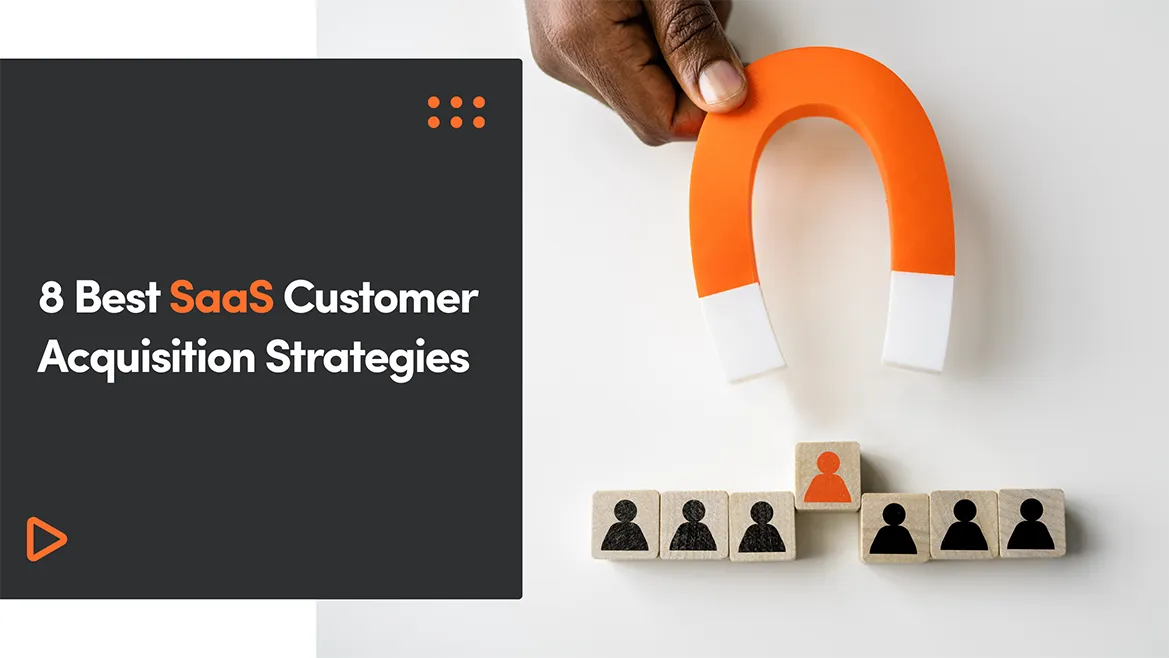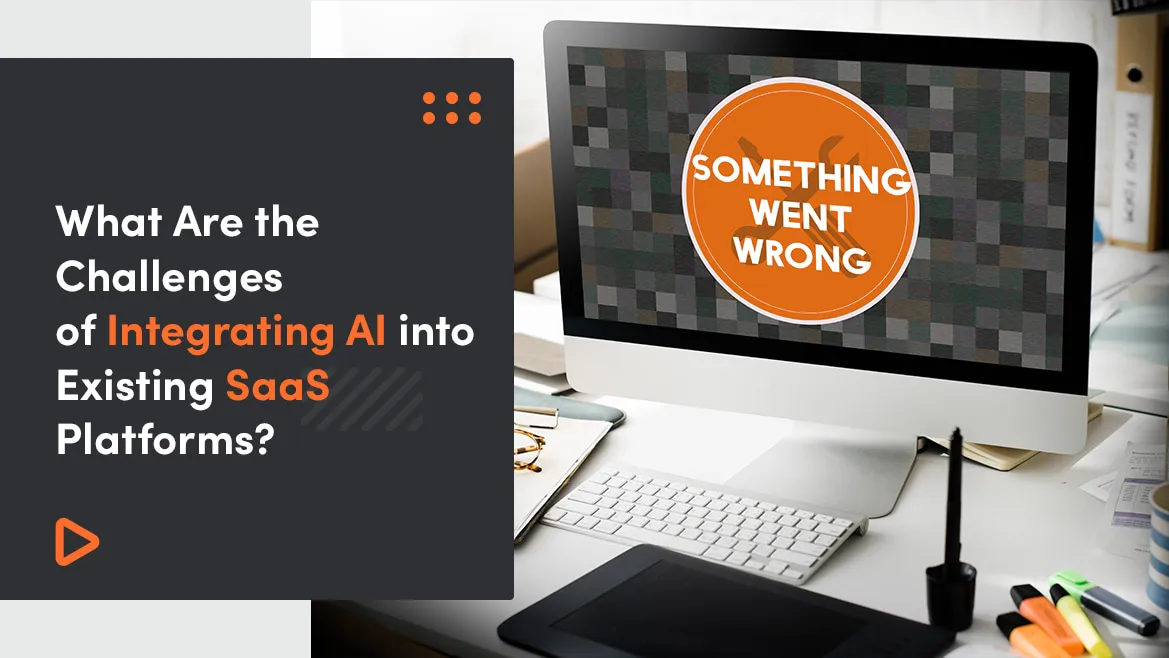A SaaS company's long-term success depends on constantly recruiting new clients and maintaining them for as long as feasible.
The success rate of selling to a new customer is 5-20%, whereas selling to an existing customer is 60-70%, which means customer acquisition requires more effort than customer retention.
While this may appear straightforward, finding new opportunities for development and client acquisition in the overcrowded SaaS industry may be difficult. SaaS solutions often have a somewhat longer sales cycle. The typical sales cycle for a SaaS startup is approximately three months. That's a long time to be hunting someone down and convincing them to buy SaaS products.
What will you learn from this article?:
- Why customer acquisition strategy is important?
- Stages of SaaS customer acquisition
- Acquisition strategies - how to get loyal customers?
- Acquisition channels - referrals and testimonials
- Analyzing and improving acquisition methods
- Benefits of customer acquisition strategy
As of 2023, Statista Business Insights projects that the Software as a Service industry will generate $253.9 billion in sales, up from $213.9 billion in 2022. Every SaaS business wants the maximum share of this billions of dollars industry, but few companies can implement a successful customer acquisition process.
Canva, a SaaS-based designing software, has become one of the world's biggest privately-owned companies after being valued at $40 billion. Since its launch in 2012, it has gained users in 190 countries. According to business data provider CB Insights, Canva's $40 billion valuation makes it the fifth-most valuable start-up in the world. Canva has implemented many customer acquisition strategies, including influencer marketing, paid ads, and educational guides for beginners to reach this height of success. The proof of Canva's success is the year-to-year growth in its revenues.
According to the reports, Canva generated around $23.5 million in 2016 and 2017. It generated $86.3 million in 2018, $291 million in 2019, $500 million in 2020, $1 billion in 2021, and reached a tremendous mark of $4 billion by the end of 2022.
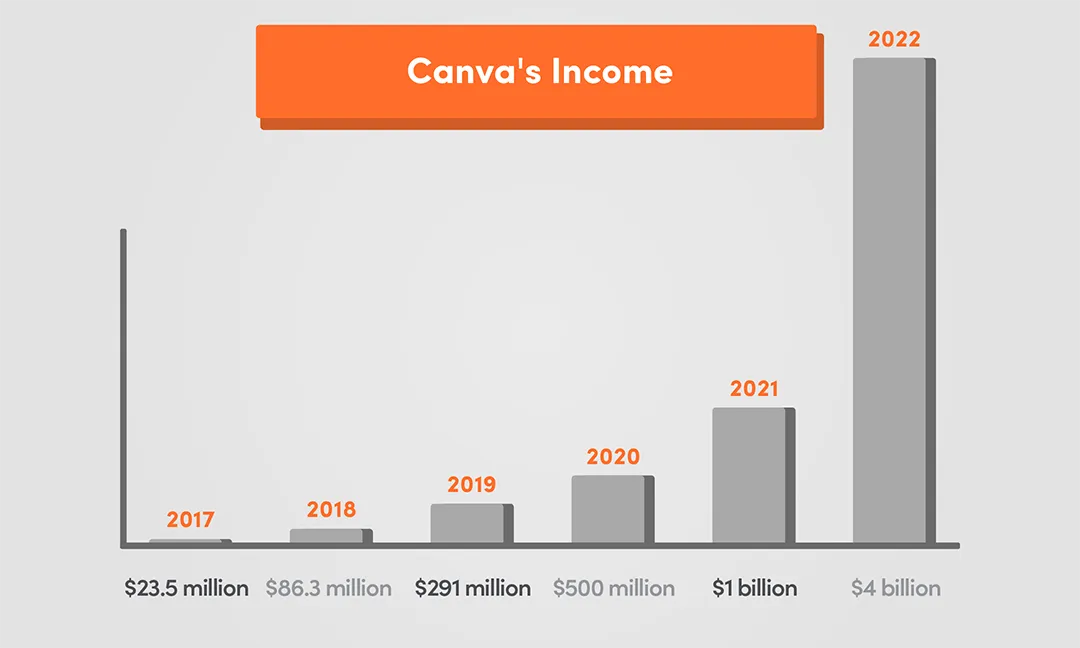
However, to adequately bridge marketing and sales, you must have powerful customer acquisition techniques that achieve the objectives. Fortunately, we can assist by offering clear instructions in this article on creating an effective client acquisition plan for a SaaS business.
Why Is It Important to Have a Unified SaaS Customer Acquisition Strategy?
For marketers seeking new, more genuine connections, it is essential to have a unified customer acquisition plan, which is a coordinated approach to acquiring new customers throughout your acquisition activities. Some of the biggest benefits of focusing specifically on customer acquisition include:
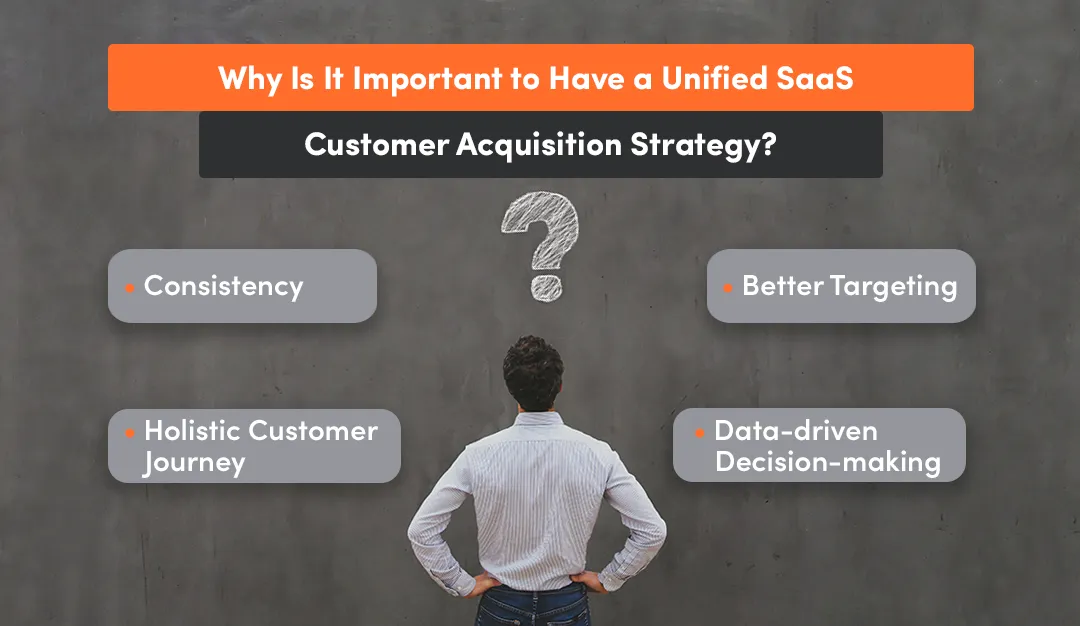
Consistency: Brands can develop constant customer experiences, branding, content, story, and placement throughout all channels and touchpoints with the help of connected customer acquisition efforts.
Better targeting: Keeping customer acquisition strategies aligned with ideal client preferences can help companies better target potential prospects. Conveying the appropriate message to the potential new customers at the appropriate moment is very important. It also makes it possible to adjust the narrative as necessary.
Data-driven decision-making: With Unified CA, diverse data (such as customer lifetime value, e-commerce data, and demographics) can be more effectively integrated across all marketing campaigns and initiatives. It also implies that all the company's data can be operationalized into insightful consumer insights.
Holistic customer journey: A smooth customer journey begins with linking and integrating each step of the client acquisition process, from the initial engagement to the final transaction. This is known as the holistic customer journey. A brand won't be able to understand how customers interact, what they want, or how to best satisfy them until after that. This optimization significantly impacts acquisition and visibility in organic search.
Stages of SaaS Customer Acquisition
SaaS's customer acquisition strategy can be broken down into three important phases: lead generation, lead nurturing, and retention. This allows the company to understand what the customer needs to serve them better.
SaaS Lead Generation
This is the first and most challenging stage of the customer acquisition strategy. With such a crowded SaaS industry it is very difficult for customers to sign up for a product. At this stage, the company is contacting prospects who have zero knowledge about the company. They do not know about the product, how it works, how it can help resolve their problems, and whether they can trust the company.
So, in the lead generation stage, a company needs to aim for two things. First, introduce the company and the product to the prospects and make them aware that they have the problem and only your product can resolve it.
They also need to create a list of target audiences and buyer personas to identify ways and channels to reach them. For example, for a SaaS startup, with 700 million-plus users, LinkedIn is a better channel to target the decision-makers of a business.
SaaS Lead Nurturing
The first stage involved knowing potential customers and letting them learn more about the company and product. The second stage, lead nurturing, is all about convincing target prospects to make purchases. In some ways, this is easier than the first stage.
The most important thing to do in this stage is to map a prospect's journey from becoming a potential lead to a marketing lead to a paying customer.
Educate them on the product uses and its benefits. Educate them regarding industry trends and market norms. Content, community, and social marketing are the best channels to convince prospects. Promotional mailers, regular discount offers, and newsletters are the key components to include in the second phase of the customer acquisition efforts.
Lead nurturing emails have a 4-10 times better response rate than stand-alone blast emails. Businesses that use email marketing automation with prospects experience witness a 451% increase in qualified leads.
Sales And Retention
After sales, the next and last stage of a SaaS customer acquisition cycle is Retention. One of the biggest reasons for SaaS business failure is the Churn Rate. The average churn rate for SaaS companies is around 10 - 14% annually. Most SaaS companies focus too much on gaining new leads and converting, and they forget to put efforts into retaining existing customers. Increasing customer retention by 5% can increase direct sales from 25-95%.
Acquiring a new customer can cost five times more than retaining an existing customer.
Reducing the churn rate and retaining existing customers should be the second most important priority for the customer acquisition cycle. If a company fails to deliver its services effectively to existing customers and churns, then it means something is seriously wrong with the system or processes.
Try our developers.
Free for 2 weeks.
No risk. Just results. Get a feel for our process, speed, and quality — work with our developers for a trial sprint and see why global companies choose Selleo.
Effective Customer Acquisition Strategies - 8 Things to Consider
If your marketing staff can access the correct data and insights, they can choose the right customer acquisition channels. Choose the platforms and technologies your potential new customers are most comfortable with, then begin with the appropriate acquisition tactics. Set goals and track progress to help decide what to maintain and what isn't worth the time.
The following strategies can help increase customer acquisition.
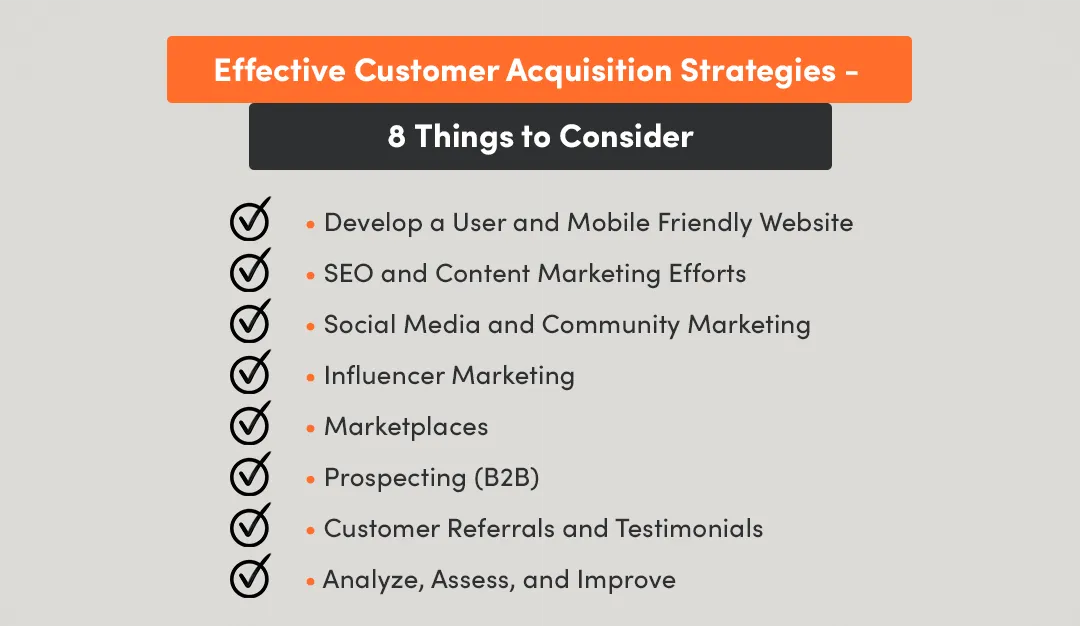
Develop a User and Mobile Friendly Website
A business's website is a conduit between products and prospective clients. It serves as a pitch, catalog, visit card, and explanatory pamphlet. From this angle, the website should be educational, entertaining, and easy to navigate.
A user should be able to easily identify which page has the required information and what will happen when they click the buttons. A website has to load quickly and work well on mobile devices. No one should wait more than 3 seconds for the homepage to load.
The website should be mobile-friendly and work similarly on smart devices like desktops and laptops.
Mobile optimization is very important for a SaaS company's website because, as per researchers, sales are expected to account for 45% of the US e-commerce sector by 2025, according to a survey published by Insider Intelligence. To draw in new clients, optimizing for mobile is a valuable investment.
Search Engine Optimization and Content Marketing Efforts
Search engine optimization is one of the most significant strategies for acquiring new customers for any organization. SEO is also one of the most common types of online practice that seeks to attract potential customers.
There is no such thing as a one-size-fits-all SEO checklist today, but there are certain best practices.
Get a technical SEO audit to ensure hidden technical issues are not hampering website performance in search engines. Then, ensure that the content plan contains consistent, high-quality material that addresses new customers' primary concerns and needs.
Is content marketing a part of SEO strategy?
Content marketing draws people to websites, introduces them to the company, or engages with them. On-site SEO material, on-site sales content, email content, video, social, PDFs, and other forms of content are all part of a content marketing plan. This will entail giving them advice, information, or answers to their concerns. Blogs, podcasts, infographics, how-to tutorials, and videos are some prominent examples.
According to SEMrush, 97% of businesses polled believe content is the soul of all customer acquisition channels.
Does video marketing come under content marketing?
Yes. Video content can refer to recorded videos published on the website, uploaded on streaming sites such as YouTube, or live videos uploaded on social media platforms such as Facebook, TikTok, or Instagram.
Its adaptability makes Video marketing a powerful tool for acquiring potential customers.
According to a Wyzowl survey, 81% of marketers claim that video has directly increased their company's sales. In comparison, 94% of marketers say video has improved consumers' comprehension of their product or service.
For video marketing, use audience data to identify themes that new customers are interested in. Another more economical tactic is content creation; according to SerpWatch, it costs 62% less on average than more conventional forms of advertising, such as sponsored placements. In addition, for every dollar invested, content marketing produces three times as many leads.
Social Media and Community Marketing
Organizations cannot afford to neglect maintaining an active social media presence. With three million companies on Facebook alone and over 4.59 billion users on social media globally, as Statista reported, ensuring the brand is present on social media platforms is a crucial component of any customer acquisition plan. This includes both organic posts and paid ads.
Companies can connect with potential customers through the comments and content on organic postings to broaden their audience's horizons and get their brand in front of new customers, providing thought-provoking and humorous branded and non-branded material.
Most social networks offer hyper-focused paid advertisements, which makes them valuable. You can locate that niche on social networks.
Is community marketing a part of social media channels?
Online community marketing helps draw users through various online activities focused on community development. It can be referred to as a part of the social profiling of the company.
Many businesses use platforms like Facebook, Slack, and Discord to build and maintain their communities. Regular gatherings and conferences are also used to deepen the bonds within the community.
Influencer Marketing
Influencer marketing is a collaboration or partnership between industry popular idols, celebrities, and popular social-media stars with a company to promote brands' products or services. These partnerships can be formal or informal, involving websites, magazines, blogs, vlogs, social media posts, stories, and live video transmission.
A company can collaborate with a prominent figure or celebrity willing to promote the business. Depending on what the company or influencer agrees upon, the payment can be in the form of money, free products, or commission.
Remember that micro and nano influencers typically have more engaged, devoted followers who value their opinions. The best platforms for influencer marketing include Instagram, YouTube, LinkedIn, and TikTok.
Marketplaces
Marketplaces like Amazon and eBay are e-commerce platforms that allow businesses to attract many visitors, providing more opportunities to sell products and reach a wider audience.
According to research conducted by Malcolm Smith of Bloomforth, 55% of the businesses selling on marketplaces have earned 20% more profit.
Each online marketplace has unique requirements, product categories, listing fees, and audiences. Some upfront research is necessary to ensure that the right decision is made.
Some well-known marketplaces for SaaS products include Product Hunt and Appsumo.
With marketplaces like Product Hunt and AppSumo, SaaS businesses can easily sell their products to a huge customer base. AppSumo is a popular online marketplace for various lifetime discounted deals and subscriptions for tools and software. This Texas-based company has been in the market for a few years and has won the trust of around 700,000+ marketers and business owners.
Product Hunt is a well-known platform where many businesses hunt for SaaS products and tools.
Prospecting (B2B)
Through prospecting, a business can get in touch and collaborate with potential customers whose requirements and preferences align with product offerings. It helps understand the problems that a potential customer is facing and ensures that a business reaches out to those who will be open to the offer.
More than seven out of ten purchasers prefer to hear from salespeople early in the purchasing process, according to research from RAIN Group. Indeed, 82% of customers agree to a meeting when a salesperson initiates contact.
Prospecting can seem more sensible and focused when aware of the company's aims and strategy. Knowing where a company is investing or expanding can show its unique interests and problems, which will help businesses create more carefully considered, targeted value offers.
To begin with, a company's careers website is an excellent resource. A company's employment board is one of the most trustworthy, open-access sites to obtain that information.
Suppose you are a marketing solutions vendor; part of the offering is a content management system. In case a firm posts job openings for several content marketing positions, you can alter the proposal to emphasize the advantages of your content management system.
In addition, if your prospect's firm is open to the public, you can review the "Risk Factors" part of their yearly financial report, generally known as a 10-K, to see whether your product offering and the company's declared financial challenges correspond.
Customer Referrals and Testimonials
A well-liked method of gaining new clients is through referral programs, which pay clients for referring you to others. They save or earn more the more new clients they recommend.
This is a successful customer acquisition method because it encourages current consumers to stay involved with the brand and presents the company to potential customers authentically.
Recommended clients have 16% higher lifetime values, spend 13% more, and are 18% more loyal than non-referred customers, according to a SaaSquatch survey.
It is easy to set up a referral scheme. Make a page on the website or a blog post with all the information once you decide what incentive you want to provide. Inform interested clients and consumers about the new program with a brief email afterward. Include it in the sales team's procedure for closing new business and remind clients about it frequently.
How to use testimonials to acquire customers?
A great way to increase customer acquisition is to utilize testimonials and reviews from satisfied clients as powerful marketing tools. Reviews and testimonials give a company credibility while leveraging the power of word-of-mouth advertising.
Collect testimonials by asking current customers for favorable stories or reviews and then put them to use. Share them as stand-alone case studies, interviews, or product evaluations. On product pages, provide quotations and star ratings. Incorporate user reviews into email marketing efforts. Share brief testimonials on social media platforms.
You can also request that consumers submit evaluations on third-party websites like Google or marketplaces where you meet clients. Many potential buyers form their initial impression of the brand by Googling the company's name and studying the data on the SERP sidebar.
Analyze, Assess, and Improve
By defining the potential new customers, a business can ensure that appropriate consumers see the product or service to optimize return on investment. To determine which buyers to target, gather demographic information and do market research.
Companies can connect with the target audience by gathering demographic data such as location, age, and past browsing and purchasing patterns.
Successful businesses follow one rule: speak on how amazing clients will be when they use your product, not how terrific the business is.
You can be ecstatic with the services you've built using cutting-edge technology. When a lead contacts you to inquire about the product, you should cease worrying about advertising the brand. You should truly concentrate on how to assist them in reaching their objectives.
This is a frequent shortcoming of many IT companies: they use technical jargon to convey the benefits of their client's products. When attempting to define "data export feature value," it is preferable to state that this feature will make it possible to create many reports. Customers want their work completed at the end of the day. Instead of demonstrating how it is achieved within your product, show them the outcome they will receive.
How to improve and acquire customers?
Social proofs are the new money in the world we live in. You can put the logos of well-known businesses you collaborated with on the home page. Write case studies explaining your clients' identities, issues, and how the product or service addressed them.
Ideally, you can present the outcomes in precise numerical form rather than using general terms like "they improved, they grew, or they reduced." Including endorsements and sincere suggestions to utilize the product in customer success stories would be fantastic.
Benefits of Creating a Customer Acquisition Strategy
A customer acquisition strategy is a way to expand business clientele, reach new markets, and boost revenue for the business. A company's successful customer acquisition strategy will be based on how it defines acquisition. Some companies only see a transaction as a legitimate acquisition, and some companies consider having a long customer lifetime value as the return on customer acquisition strategy.
By implementing a customer acquisition strategy, a business will be able to achieve the following benefits:
Better Identification of Potential New Customers
The behaviors and characteristics of the highest-value consumers can be identified by gathering, evaluating, and creating customer profiles, researching competitors, and examining market research trends. To attract those prospects to the company's website, you can spend time and money on the appropriate customer acquisition methods, such as social media, SEO, or paid advertisements.
Better Connection with Customers
A business can gain the knowledge necessary to build deeper relationships with clients and boost conversion rates by working to optimize the customer acquisition approach. You can engage the audience and build brand trust by sending a highly personalized message to a single lead or a timely message to potential new customers.
Better and Increased ROI
By defining the potential new customers when developing a client acquisition plan, a business can prioritize marketing efforts and avoid wasting money on campaigns that won't reach the right target audience. The total return on investment (ROI) from marketing initiatives for the company will rise if you allocate the budget wisely.
Better Growth in New Customer Acquisition
While increasing the number of views on a campaign or advertisement is crucial to a marketing plan, ROI is not increased. Converting potential clients into paying customers is crucial to an effective customer acquisition strategy. This is accomplished by offering the audience something of value in the form of a good or service that they require, taking into account information such as their shopping habits, place of residence, and more. A new customer can encourage recommendations and conversions by providing value and an excellent purchasing experience.
Better Growth in Branding and Revenues
Businesses must expand the consumer base to build the brand and boost revenue. Using an effective customer acquisition approach, a company can attract high-value audiences and persuade them to purchase.
Is a Customer Acquisition Strategy for Startups Different From That for Bigger Companies?
Customers are a company's vital force. Therefore, every business needs a plan to consistently attract new clients, but, as per ProfitWell, the expenses associated with acquiring new clients have increased by 50% in the previous five years.
The major difference between creating an acquisition strategy for a startup and a large corporation is the difference in customer acquisition cost and optimal lifetime value.
Large SaaS corporations like Slack, Magento, HubSpot, Adobe, Oracle, and many others spend millions, if not billions, on their acquisition strategy. In return, they obtain hundreds of thousands of customers due to the brand value that they have built over many years. The ratio of spending millions on acquisition costs with hundreds and thousands of customers gained brings down the customer acquisition cost.
A startup, on the other hand, does not have the financial capability to spend millions on testing and branding. Therefore, the amount spent on customer acquisition strategies should ensure a return in the form of new customers. If the number of new customers obtained is not good enough, the customer acquisition cost will automatically increase for startups.
Let's better understand how the Cost of Customer Acquisition differentiates strategies for large corporations and startups.
The cost of acquiring a new client, including marketing, research, sales, and product costs, is the customer acquisition cost (CAC). A business can also assess the acquisition strategy's return on investment (ROI) using customer acquisition cost.
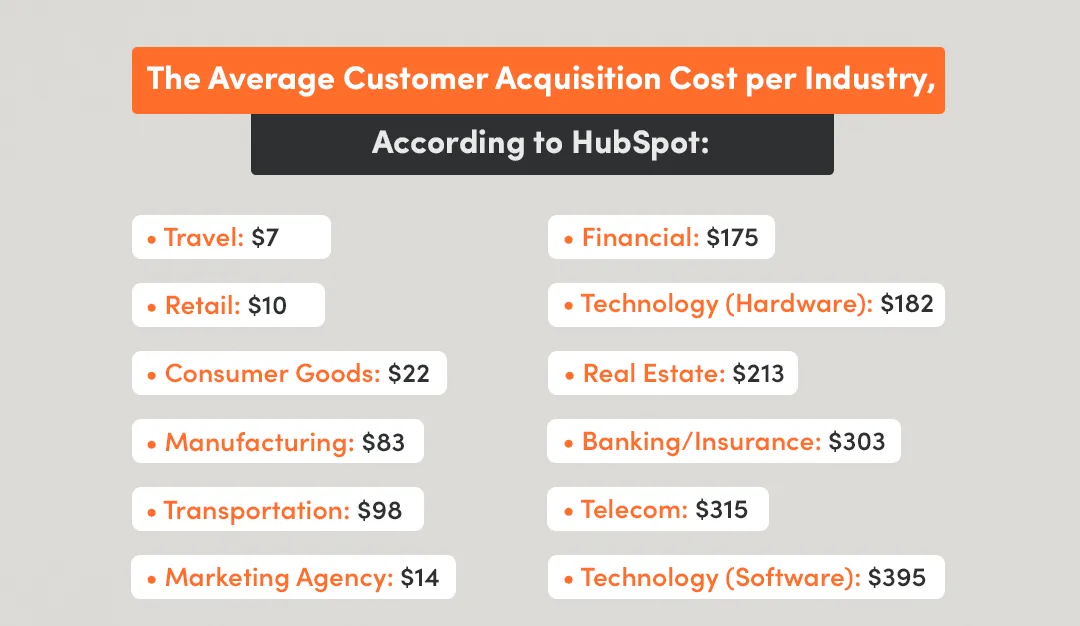
The average customer acquisition cost per industry, according to HubSpot, is:
- Travel: $7
- Retail: $10
- Consumer Goods: $22
- Manufacturing: $83
- Transportation: $98
- Marketing Agency: $14
- Financial: $175
- Technology (Hardware): $182
- Real Estate: $213
- Banking/Insurance: $303
- Telecom: $315
- Technology (Software): $395
Here are some of the major differences in customer acquisition strategy of a large SaaS corporation and a startup:
Website
Large Corporation: Most large SaaS corporations have an excellent website optimized for mobile experiences. All the necessary sections are available to guide customers, such as blogs, how-to guides, tutorials, industry news, a list of features, testimonials, policies, terms and conditions, etc.
Startup: A SaaS startup may have a simple website with just essential information about the product. It may lack other necessary details. Many startups failed to create mobile-friendly websites, which took over three seconds to load the home page.
Social Media Posts
Large Corporation: SaaS-based corporations have a very strong presence on social media, with thousands or millions of followers. Slack's official Facebook page has 134K followers. These businesses post daily and sometimes twice or thrice a day. These corporations spend a good amount of money on social media customer acquisition strategies.
Startup: It took months for startups to gain followers on social media accounts due to their new existence. Many startups failed to gain organic followers at all. Most startups keep social media customer acquisition strategy at a low priority due to a lack of skills and funds.
Email Marketing
Large Corporation: Email marketing is one of the key components for large corporations' customer acquisition strategy mainly because they have a huge database of subscribers with whom the company keeps close contact. Monthly newsletters, promotional emails, updates, and discount offers are the key elements of email marketing acquisition strategy.
Startup: In the initial stage, startups do not have a database to send emails. These startups hunt leads from different platforms, such as LinkedIn, or buy a database from third-party companies. However, email marketing is one of the key components of a startup acquisition strategy.
Influencer Marketing
Large Corporation: Large corporations usually do not need to spend money to gather influencers. Celebrities, social media stars, and industry gurus endorse the product themselves for affiliation with the company. For instance, you can watch many videos for BigCommerce on YouTube where people suggest the company's products.
Startup: Startups lack the funds to include influencer marketing in their acquisition strategy. This element is always the lowest priority.
Paid Advertising
Large Corporation: Paid advertising is one of the key elements of SaaS corporate's acquisition strategy as they spend millions every year to run ads not only on Google but also on Bing, Yahoo, Social Media Platforms, and magazines.
Startup: Small SaaS companies run paid ads on Google, Bing, and Linkedin at the initial stage with a low budget until they start getting returns on the investment. Paid advertising can either be a successful element or a failed attempt for small companies' acquisition strategy.
Customer Service Team
Large Corporation: 24/7 live chat, ticket system, and phone support are key for SaaS corporation's acquisition and retention strategies.
Startup: Small SaaS companies lack this element. Most of the time, these companies only offer ticket support for customers acquired.
Referrals
Large Corporation: A huge portion of the sales of large SaaS corporations is based on their referrals and affiliates. A one-time investment and the companies keep getting returns for years.
Startup: Small companies do not usually add referrals and affiliation in their initial customer acquisition strategy due to a lack of brand value and recognition among the target audience.
Summary
The acquisition process might not always be straightforward - especially at the beginning of a SaaS company. It is best to be well-prepared before pursuing new clients. Do you have a website or landing page to welcome your prospects? Are you aware of your target market and how to reach them so they can advance through the sales funnel?
Select one or two of the strategies mentioned above as the initial steps when ready to launch or enhance the customer acquisition plan. From the outset, define specific, quantifiable targets and, after a predetermined amount of time, assess both progress and CAC. Continue using an approach if it is effective. Transfer those resources to another if one doesn't prove to be successful.
